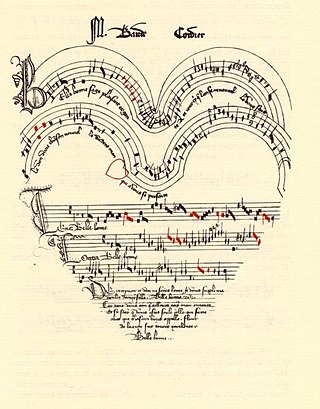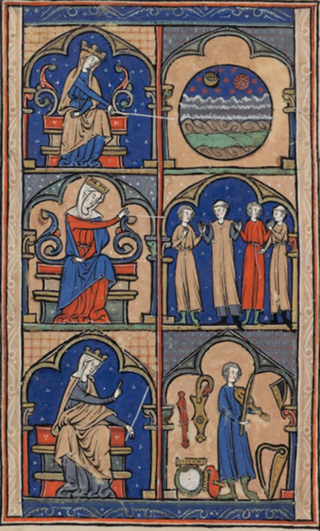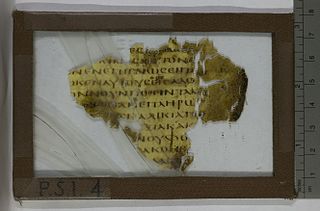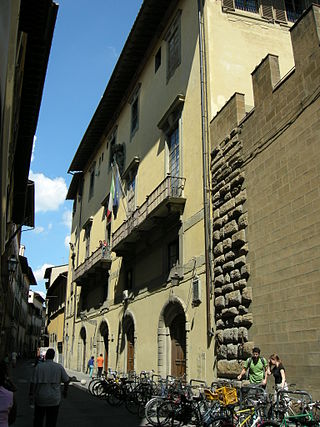Organum is, in general, a plainchant melody with at least one added voice to enhance the harmony, developed in the Middle Ages. Depending on the mode and form of the chant, a supporting bass line may be sung on the same text, the melody may be followed in parallel motion, or a combination of both of these techniques may be employed. As no real independent second voice exists, this is a form of heterophony. In its earliest stages, organum involved two musical voices: a Gregorian chant melody, and the same melody transposed by a consonant interval, usually a perfect fifth or fourth. In these cases the composition often began and ended on a unison, the added voice keeping to the initial tone until the first part has reached a fifth or fourth, from where both voices proceeded in parallel harmony, with the reverse process at the end. Organum was originally improvised; while one singer performed a notated melody, another singer—singing "by ear"—provided the unnotated second melody. Over time, composers began to write added parts that were not just simple transpositions, thus creating true polyphony.

Ars subtilior is a musical style characterized by rhythmic and notational complexity, centered on Paris, Avignon in southern France, and also in northern Spain at the end of the fourteenth century. The style also is found in the French Cypriot repertory. Often the term is used in contrast with ars nova, which applies to the musical style of the preceding period from about 1310 to about 1370; though some scholars prefer to consider ars subtilior a subcategory of the earlier style. Primary sources for ars subtilior are the Chantilly Codex, the Modena Codex, and the Turin Manuscript.

The Institute of the Italian Encyclopedia Treccani, also known as the Treccani Institute, is a cultural institution of national interest, active in the publishing field, founded by Giovanni Treccani in 1925.

The Rabbula Gospels, or Rabula Gospels is a 6th-century illuminated Syriac Gospel Book. One of the finest Byzantine works produced in West Asia, and one of the earliest Christian manuscripts with large miniatures, it is distinguished by the miniaturist's predilection for bright colours, movement, drama, and expressionism. Created during a period from which little art survived, it nevertheless saw great development in Christian iconography. The manuscript has a significant place in art history, and is very often referred to.

The Squarcialupi Codex is an illuminated manuscript compiled in Florence in the early 15th century. It is the single largest primary source of music of the 14th-century Italian Trecento.

The Magnus Liber or Magnus liber organi, written in Latin, is a repertory of medieval music known as organum. This collection of organum survives today in three major manuscripts. This repertoire was in use by the Notre-Dame school composers working in Paris around the end of the twelfth and beginning of the thirteenth centuries, though it is well agreed upon by scholars that Leonin contributed a bulk of the organum in the repertoire. This large body of repertoire is known from references to a "magnum volumen" by Johannes de Garlandia and to a "Magnus liber organi de graduali et antiphonario pro servitio divino" by the English music theorist known as Anonymous IV. Today it is known only from later manuscripts containing compositions named in Anonymous IV's description. The Magnus Liber is regarded as one of the earliest collections of polyphony.

The Winchester Troper refers to two eleventh-century manuscripts of liturgical plainchant and two-voice polyphony copied and used in the Old Minster at Winchester Cathedral in Hampshire, England. The manuscripts are now held at Cambridge, Corpus Christi College 473 and Oxford, Bodleian Library Bodley 775 . The term "Winchester Troper" is best understood as the repertory of music contained in the two manuscripts. Both manuscripts contain a variety of liturgical genres, including Proper and Ordinary chants for both the Mass and the Divine Office. Many of the chants can also be found in other English and Northern French tropers, graduals, and antiphoners. However, some chants are unique to Winchester, including those for local saints such as St. Æthelwold and St. Swithun, who were influential Bishops of Winchester in the previous centuries. Corpus 473 contains the most significant and largest surviving collection of eleventh-century organum. This polyphonic repertoire is unique to that manuscript.

Trouvère, sometimes spelled trouveur, is the Northern French form of the langue d'oc (Occitan) word trobador, the precursor of the modern French word troubadour. Trouvère refers to poet-composers who were roughly contemporary with and influenced by the trobadors, both composing and performing lyric poetry during the High Middle Ages, but while the trobadors composed and performed in Old Occitan, the trouvères used the northern dialects of France. One of the first known trouvère was Chrétien de Troyes and the trouvères continued to flourish until about 1300. Some 2130 trouvère poems have survived; of these, at least two-thirds have melodies.

Papyrus 35, designated by 𝔓35, is an early copy of the New Testament in Greek. It is a papyrus manuscript of the Gospel of Matthew, it contains only Matthew 25:12-15.20-23. The manuscript paleographically has been assigned to the 3rd or 4th century.

Uncial 0172, is a Greek uncial manuscript of the New Testament, dated palaeographically to the 5th century.
Uncial 0174, is a Greek uncial manuscript of the New Testament, dated paleographically to the 5th century.

Uncial 0175, is a Greek uncial manuscript of the New Testament, dated palaeographically to the 5th century The manuscript has survived in a very fragmentary condition.

Uncial 0176, is a Greek uncial manuscript of the New Testament, dated paleographically to the 4th century.

Uncial 0207, is a Greek uncial manuscript of the New Testament, dated paleographically to the 4th-century.

The Biblioteca Riccardiana is an Italian public library under the aegis of the Ministry of Culture, located inside the Palazzo Medici Riccardi at 10 Via de’ Ginori in Florence, in the neighborhood comprising the Mercato Centrale and the Basilica di San Lorenzo. Its main feature is preserving books collected by members of the Riccardi family and making them available in the very same rooms that were originally dedicated to that purpose. So, still today the library boasts the magnificent bookshelves, neatly carved and gilded, that create the atmosphere of a late-seventeenth-century patrician library, whose main features have all been kept intact.

Add MS 29987 is a mediaeval Tuscan musical manuscript dating from the late fourteenth or early fifteenth century, held in the British Library in London. It contains a number of polyphonic Italian Trecento madrigals, ballate, sacred mass movements, and motets, and 15 untexted monophonic instrumental dances, which are among the earliest purely instrumental pieces in the Western musical tradition. The manuscript apparently belonged to the de' Medici family in the fifteenth century, and by 1670 was in the possession of Carlo di Tommaso Strozzi; it was in the British Museum from 1876, where it was catalogued as item 29987 of the Additional manuscripts series. It is now in the British Library.

The International Society for the Study of Medieval Latin Culture is an Italian non-profit cultural institute, based in Florence. It promotes multi-disciplinary research into the history, art, literature and philology of the medieval Latin era.

Teresa Lodi was an Italian librarian and papyrologist.
















